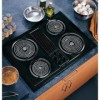GE JP389BJBB Use and Care Manual - Page 8
Modules, Using the Electric, Surface, Unit Modules - accessories
 |
UPC - 084691123736
View all GE JP389BJBB manuals
Add to My Manuals
Save this manual to your list of manuals |
Page 8 highlights
HOW DOES THIS COOKTOP COMPARE TO YOUR OLD ONE? Your new modular cooktop may have several types of cooking surface units. You will notice some differences when you use each one. The best types of cookware to use, plus heat-up and cool-down times, depend upon the type of burner or surface unit you are using. The following chart will help you to understand the differences among the various cooking surface units and how they differ from others you may have used in the past. Type of Cooktop Radiant (Glass Ceramic) Cooktop O Induction Electric Coil Solid Disk Description Electric coils under a glassceramic cooktop. How it Works Heat travels to the glass surface and then to the cookware, so pans must be fiat on the bottom for good cooking results. The glass cooMop stays hot enough to continue cooking after it is turned off. Remove the pau from the surface unit if you want cooking to stop. High frequency induction coils under a glass surface. Flattened metal tubing containing electric resistance wire suspended over a drip pml. Solid cast iron disk sealed to the cooklop surface. Regular or sealed gas burners use either LP gas or natural gas. Ptms must be made of ferrous metals (metal that attracts a magnet). Heat is produced by a magnetic circuit between the coil aud the ptm. Heals up right away aud ch_mges heal settings right away, like a gas cooMop. After tuming the control off, the glass cooMop is hot from the heat of the ptm, but cooking stops right away. Heats by direct contact wifll the p_mand by heating the air under the pan. For best cooking results, use good quality p_ms. Electric coils are more forgiving of warped p_ms them radiaut or solid disks. Heats up quickly but does not change heat settings as quickly as gas or induction. Electric coils stay hot enough to continue cooking for a short time after they are turned off. Heats by direct contact with the pau, so p_msmust be fiat on the bottom for good cooking results. Heats up and cools down more slowly them electric coils. The disk stays hot enough to continue cooking after it is turned off. Remove the pan from the solid disk if you w_mtthe cooking to stop. Flames heat the Dins directly. Pan flamess is not critical to cooking results, but p_ms should be well bal_mced. Gas burners heat the pan right away and change heat settings right away. When you tuna the control off, cooking stops right away. Care of the Modules Some of the modules must be cured or preconditioned before using them for the first time. Modules and accessories should be cleaned after each use. The longer a soil remains, the harder it is to clean. See each module section in this guide for specific instructions. Never immerse any module in water. Using the Electric Surface Unit Modules You must consider heat up and cool down times for the electric surface units when determining cooking times. Heat up and cool down times depend on initial temperature settings, the type of cookware used and the amount of food being cooked. 8 When not in the cooktop, modules and accessories should be stored in a clean, dry place. Always be careful not to drop the modules or they could be damaged. Start cooking at a higher setting to heat the surface unit faster, then turn to a lower setting to finish cooking. Remember, cooking continues after the surface unit is turned off.















